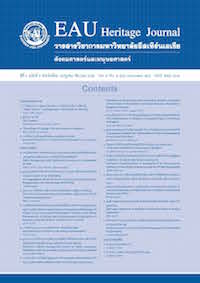การพัฒนารูปแบบการบริหารจัดการโรงเรียนในฝัน
Keywords:
ผู้บริหารและการนำรูปแบบการจัดการโรงเรียน, administrator and implementationAbstract
การวิจัยนี้มีวัตถุประสงค์ เพื่อพัฒนารูปแบบการบริหารจัดการโรงเรียนในฝัน โดยดำเนินการ 3 ขั้นตอน คือ (1) ศึกษา แนวคิด ทฤษฎีและงานวิจัย ศึกษากรณีตัวอย่างโรงเรียนในฝันที่ประสบความสำเร็จ จำนวน 3 โรงเรียน และ ศึกษาความคิดเห็นของผู้ทรงคุณวุฒิ ด้านการบริหารการศึกษา จำนวน 4 คน ร่างรูปแบบ การบริหารโรงเรียนในฝัน (2) พัฒนารูปแบบการบริหารจัดการโรงเรียนในฝัน จัดสนทนากลุ่ม ผู้ทรงคุณวุฒิด้านการบริหารการศึกษา ด้านการวิจัย ผู้บริหารโรงเรียนในฝัน ผู้บริหารสถานศึกษา และผู้ให้การนิเทศด้านโรงเรียนในฝัน จำนวน 24 คน (3) ตรวจสอบ คุณลักษณะของรูปแบบการบริหารจัดการโรงเรียนในฝัน ด้วยข้อมูลเชิงปริมาณ จากกลุ่มตัวอย่างที่เป็นผู้บริหารและครู 416 คน ในโรงเรียนต้นแบบ 72 โรงเรียน และตรวจสอบคุณลักษณะของรูปแบบด้วยการสัมภาษณ์ผู้บริหารและครูโรงเรียน ต้นแบบ จำนวน 4 โรงเรียน ผลการวิจัยพบว่า (1) รูปแบบการบริหารจัดการโรงเรียน ที่ร่างมี 5 องค์ประกอบเช่นเดียวกัน กบั รปู แบบทีพ่ บจากการศกึ ษาเบือ้ งตน้ คอื หลกั การบรหิ ารจดั การวตั ถปุ ระสงคข์ องโรงเรยี น โครงสรา้ งของโรงเรยี น กลยทุ ธ ์ ของโรงเรียน เงื่อนไขความสำเร็จ (2) รูปแบบการบริหารจัดการโรงเรียนในฝัน ที่สร้าง มี 5 องค์ประกอบ คือ หลักการ บริหารจัดการ วัตถุประสงค์ของโรงเรียน โครงสร้างของโรงเรียน กลยุทธ์ของโรงเรียน เงื่อนไขความสำเร็จ (3) ผลที่ได้จาก ผู้ทรงคุณวุฒิ พบว่า องค์ประกอบรูปแบบการบริหารจัดการ มีลักษณะแนวคิดเชิงระบบ ประกอบด้วย ปัจจัยนำเข้า 3 องค์ประกอบ คือ วัตถุประสงค์ของโรงเรียน หลักการบริหารจัดการ และโครงสร้างการบริหาร ปัจจัยกระบวนการ 1 องค์ประกอบ คือ กลยุทธ์การดำเนินงาน ปัจจัยผลผลิต 1 องค์ประกอบ คือ ภาพความสำเร็จ 2 องค์ประกอบ คือ สภาพแวดล้อมของ และการประเมิน ปรับปรุง และพัฒนา (4) การตรวจสอบคุณลักษณะของรูปแบบด้วยข้อมูลเชิงปริมาณ และข้อมูลเชิงคุณภาพ มีความสอดคล้องกับคุณลักษณะของรูปแบบการบริหารจัดการโรงเรียนในฝันทั้งในด้าน ความมีประโยชน์ ความเป็นไปได้ ความเหมาะสม และความถูกต้อง
Development of a Model for Lab School Administration
The objectives of this study were to develop a models lab schools administration and to recommend the qualifications integral to its success. The model was developed in three steps (1) To get the profile of the model, documents were studied regarding the concepts, theories and related studies on educational administration and used a semi-structured questionnaire to interview 3 successful lab school administrators and teachers and 4 educational administrators. (2) The model was developed through a group discussion of experts which included education, lab school and school administrators, researchers, and lab supervisors, (3) The qualitative and quantitative qualifications of the model would be examined base on empirical data gathered through a questionnaire conducted on 416 administrators and teachers of 72 lab school. The findings were as follows: (1) To profile of the model lab schools administration, to be set up, incorporates 5 factors: principles and structure of administration, objectives, strategies and conditions of success, including 22 sub factors and the interview with administers and teachers from 4 schools. (2) The constructed model by the researcher included factors similarly to the two file; (3) the finding found from the experts showed the model consisted of administration teachers including 3 input factors: objective principle of administration, administrative structure and one procedural factor a success factor, plus sentimental and evaluation and development (4) When examine the model with qualitative and quantitative measure the finding showed the model of lab school proposed was careful, feasible, appropriate and correct.





